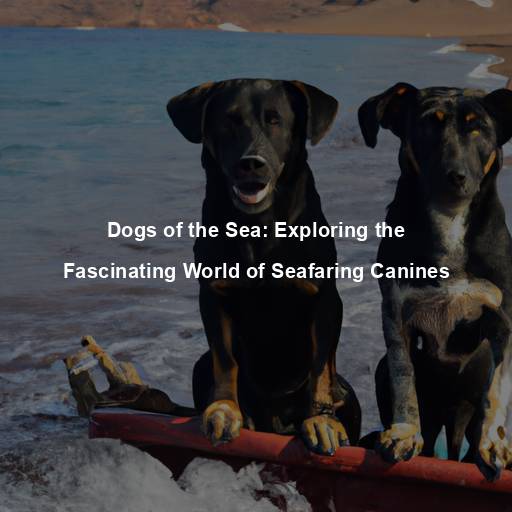Dogs of the Sea: Exploring the Fascinating World of Seafaring Canines
Last Updated on July 17, 2023 by Evan
Contents
- 1 What Are Dogs of the Sea?
- 2 Ancient Mariners and Their Canine Companions
- 3 Breeds of Dogs of the Sea
- 4 The Importance of Dogs of the Sea
- 5 Famous Dogs of the Sea
- 6 Training and Skills of Dogs of the Sea
- 7 The Bond Between Sailors and Dogs of the Sea
- 8 Preserving the Legacy of Dogs of the Sea
- 9 FAQs – What are dogs of the sea?
What Are Dogs of the Sea?
Understanding the Origins of Seafaring Canines
Dogs have long been known as man’s best friend, but did you know that some of our furry companions have also taken on the high seas? These seafaring canines, often referred to as “dogs of the sea,” have a rich history and a unique set of skills that make them perfect companions for life aboard a ship. From ancient times to present-day, these remarkable dogs have played a vital role in maritime expeditions, offering both companionship and valuable assistance to sailors. Let’s dive deeper into the fascinating world of dogs of the sea.
Ancient Mariners and Their Canine Companions
Ancient History: Sailing with Dogs
The presence of dogs on ships dates back thousands of years, with evidence of their existence found in ancient civilizations such as the Egyptians and the Phoenicians. These early mariners recognized the value of having dogs on board, as they provided protection against intruders, served as skilled hunters, and even helped to ward off pests that plagued the ships.
The Vikings: Fierce Warriors and Furry Friends
Discover the untold story of the Vikings, where strength and tenderness intertwined like the crashing waves against their vessels. Amidst their formidable reputation, these fearless seafarers carried a profound appreciation for the mystical bond between man and dog. Legends whispered of the Vikings’ faith in their loyal companions, as they were believed to embody the enigmatic qualities of the mighty Norse god Odin. Journey through time to unravel the captivating tales of these canine navigators and steadfast protectors, whose presence left a lasting impression on the heart of Viking culture.
Breeds of Dogs of the Sea
Newfoundland: A Natural Born Lifesaver
Prepare to be awestruck by the majestic and revered aquatic canines known as Newfoundlands. With their extraordinary combination of webbed feet, luscious fur, and innate swimming prowess, these gentle giants are destined to be your trustworthy sidekicks on any nautical escapade. Throughout the annals of time, these noble beings have fearlessly ventured into treacherous waters, saving stranded sailors in the process. Their unparalleled aquatic aptitude and robust physique have earned them the illustrious title of “lifeguard dogs,” epitomizing their indispensable role in water rescues.
Portuguese Water Dog: The Sailor’s Assistant
Another breed that has a strong connection to seafaring is the Portuguese Water Dog. Originating from the coastal regions of Portugal, these intelligent and agile dogs were originally bred to assist fishermen at sea. Equipped with webbed feet and a waterproof coat, Portuguese Water Dogs excel in tasks such as retrieving nets, diving, and even message delivery between ships. Their versatility and loyalty have made them a popular choice among sailors throughout history.
Jack Russell Terrier: The Rat Catcher
Throughout history, various dog breeds have showcased their unique talents and indispensability in seafaring endeavors. While larger breeds such as the Newfoundland and Portuguese Water Dog have rightfully earned their place as maritime companions, it’s intriguing to discover the significant contributions of smaller breeds as well. Among them, the Jack Russell Terrier emerges as a true hero of the high seas, renowned for their tireless energy and unwavering persistence. These pint-sized powerhouses held vital roles as rat catchers aboard ships, effectively safeguarding the vessel and its occupants from the perils of disease-transmitting rodents.
The Importance of Dogs of the Sea
Companionship and Mental Well-being
Life at sea can be challenging, isolating, and mentally demanding for sailors. Dogs of the sea provide much-needed companionship and emotional support to the crew members, helping to alleviate feelings of loneliness and offering a sense of comfort in the midst of long voyages. The unconditional love and loyalty of these furry friends can greatly contribute to the mental well-being of sailors, providing a much-needed boost during their arduous journeys.
Safety and Security
Sailors are finding solace in having their furry companions on board, as dogs bring an unparalleled sense of security in the vastness of the open seas. With an uncanny ability to detect danger, these four-legged companions practically have a sixth sense when it comes to their surroundings. Armed with acute hearing and heightened senses, they serve as the ultimate early warning system, alerting the crew to any potential threats or hazards that may lie ahead. Moreover, their protective instincts act as a formidable deterrent to unwanted visitors, safeguarding the crew and the vessel in the process.
Practical Assistance
The mesmerizing world of seafaring brings forth a cast of characters that mesmerize us with their unexpected skills and bewitching tales. Amongst them, the dogs of the sea hold a special place, for they are more than mere companions; they are truly indispensable members of the crew. With an uncanny knack for navigating the treacherous waters and an unparalleled ability to retrieve lost items from the depths, these extraordinary canines lend a helping paw in all aspects of maritime life, including daring search and rescue missions that leave us in awe of their unwavering determination and loyalty. Set sail with us as we unravel the enigmatic talents of these captivating creatures who make the ship’s operation a bewilderingly impressive dance of teamwork and safety.
From Ancient Sailing Vessels to Modern Ships
Over the centuries, the bond between seafarers and their trusty canine companions has woven a fascinating tale of adaptation and companionship upon the shifting tides of time. In the ancient days of maritime ventures, dogs gracefully graced the decks of modest sailboats, carrying out crucial tasks of hunting, safeguarding, and allaying the solitude of the vast sea. As humanity’s maritime ambitions swelled, colossal ships emerged from the waves, propelling dogs into new roles tailored to the ever-evolving needs of intrepid sailors.
The Age of Exploration: Dogs on Voyages of Discovery
During the Age of Exploration, when sailors embarked on long and perilous voyages to discover new lands, dogs were a common sight on ships. These intrepid explorers relied on their canine companions for a variety of tasks, such as hunting for food, guarding against intruders, and providing a sense of familiarity and comfort during the long and arduous journeys. Dogs of the sea became an integral part of these historic expeditions, serving as faithful companions to the brave explorers who ventured into the unknown.
Famous Dogs of the Sea
Bummer and Lazarus: San Francisco’s Legendary Duo
In the colorful tapestry of San Francisco’s past, there exists a tale that merges the extraordinary with the ordinary, the unexpected with the predictable. Bummer and Lazarus, two canine wanderers, embarked on a captivating journey that would leave an indelible mark on the hearts and minds of the city’s inhabitants. Amidst the vibrant chaos of the mid-19th century, these unlikely heroes, Bummer, a magnificent blend of Newfoundland splendor, and Lazarus, an unassuming terrier, weaved through the streets with purpose and aplomb. United by an unbreakable bond, they fearlessly maneuvered the labyrinthine alleyways, saving lives from the treacherous clutches of the San Francisco Bay.
Rigel: The Heroic Coast Guard Canine
In more recent history, Rigel, a black Labrador Retriever, made headlines for his heroic actions as a member of the United States Coast Guard. Rigel was trained as a search and rescue dog, specializing in sniffing out survivors in water emergencies. In 1995, he played a crucial role in the rescue of two fishermen whose boat had capsized off the coast of Oregon. Rigel’s keen sense of smell and unwavering dedication helped locate the stranded fishermen, ultimately saving their lives.
Training and Skills of Dogs of the Sea
Specialized Training for Maritime Environments
At first glance, one may question the connection between dogs and the vast expanse of the sea. However, the truth is, these remarkable canines undergo a rigorous and highly specialized training to equip them for the peculiar challenges that await them aboard a ship. From a tender age, they are immersed in the invigorating waters, honing their swimming abilities. As they mature, their training takes a profound twist, focusing on more intricate tasks like retrieving objects from the depths, maneuvering through confined spaces, and adapting to the constant movement and cacophony of a ship.
Essential Skills for Seafaring Canines
Seafaring canines possess a range of skills that make them invaluable assets on board a ship. Their ability to swim with ease, aided by their webbed feet and natural buoyancy, allows them to navigate the water effortlessly. Dogs of the sea are also trained to detect and respond to various signals, such as alarms or distress calls, ensuring swift action in emergency situations. Their agility, strength, and keen senses enable them to perform tasks such as tracking scents, identifying potential dangers, and even pulling lines or small rafts in rescue operations.
The Bond Between Sailors and Dogs of the Sea
A Lifeline of Friendship and Support
There is an inexplicable and enchanting kinship that exists amidst the vastness of the ocean, where sailors find solace in the steadfast companionship of their canine comrades. Bound by an unspoken camaraderie, forged through shared adventures and relentless battles against the tempestuous waves, this extraordinary connection between sailors and sea dogs defies conventional understanding. It transcends physical assistance, encompassing a profound emotional bond that nurtures sailors through the relentless solitude of their maritime journeys. Within this mystical alliance lies an invaluable wellspring of fortitude, inspiration, and serene mental equilibrium that empowers sailors to navigate the tumultuous waters of their chosen existence with unwavering determination.
Tales of Devotion and Resilience
Countless stories of dogs of the sea showcase their unwavering loyalty and devotion to their human counterparts. From staying by the side of a sick sailor, providing warmth and comfort during cold nights, to alerting the crew to approaching dangers, these remarkable canines have proven time and again their dedication and resilience in the face of adversity. These tales serve as a testament to the extraordinary relationship between humans and their seafaring companions.
Preserving the Legacy of Dogs of the Sea
Honoring the Contributions of Seafaring Canines
As we delve into the captivating world of dogs of the sea, it is essential to remember and honor the significant contributions these remarkable animals have made throughout history. Their bravery, loyalty, and invaluable skills have saved lives, provided comfort, and helped shape the course of maritime exploration. By preserving their stories and sharing them with future generations, we ensure that the legacy of dogs of the sea lives on, celebrating their extraordinary bond with humans and the indelible mark they have left on the maritime world.
FAQs – What are dogs of the sea?
What are dogs of the sea?
Seals and sea lions, often coined as the delightful “dogs of the sea,” captivate our imaginations with their uncanny resemblance to our beloved four-legged companions. Despite their distant relation to domestic dogs, these marine mammals share astonishing traits that leave us in awe. From their sleek, streamlined physiques to their playful antics and a remarkable repertoire of vocalizations, these creatures bewilder us with their unique blend of elegance and charm.
Are dogs of the sea actually dogs?
Believe it or not, the mesmerizing creatures we often mistake for furry companions are not really our lovable canines. They belong to an entirely separate league of animals, known as pinnipeds. This eclectic group includes the enigmatic seals, charming sea lions, and the formidable walruses. Although they may bear a few resemblances to our beloved domestic pets, these fascinating marine mammals possess their own extraordinary attributes and exceptional adaptations for thriving in the watery depths.
What species are considered dogs of the sea?
When it comes to the fascinating creatures known as “dogs of the sea,” we can’t help but be enthralled by the intriguing differences between seals and sea lions. Seals, belonging to the Phocidae family, boast a sleek physique, petite front flippers, and an absence of external ear flaps. In contrast, their counterparts, the sea lions from the Otariidae family, showcase larger front flippers, prominent external ear flaps, and an astonishing ability to amble on land with their flippers. These captivating creatures can be spotted in diverse corners of our planet, gracing coastal realms and occasionally venturing into the realms of freshwater habitats, leaving us in awe of their adaptability.
How do dogs of the sea survive in their marine habitat?
The enchanting world of marine canines is a captivating amalgamation of evolution and adaptability. With a physique molded by the currents of the sea, these majestic creatures possess a streamlined body that propels them through the water effortlessly. Their limbs, transformed into elegant flippers, grant them the ability to navigate the depths with an awe-inspiring grace, in relentless pursuit of sustenance. Tucked beneath the waves, a remarkable respiratory system allows them to embrace the unknown, effortlessly holding their breath for extraordinary spans of time. And lest we forget, their resilient layer of blubber, nature’s cozy blanket, ensures that the icy waters remain but an invigorating backdrop to their remarkable existence. It is this symphony of adaptations that unfurls before us, allowing these marine canids to thrive in their marine playground, forever captivating our imagination.
Do dogs of the sea live in groups?
In the world of marine mammals, both seals and sea lions have a knack for social gatherings. However, the fascinating part is that their group dynamics and social habits differ from one species to another. Seals, for instance, have a penchant for forming bustling breeding colonies on land or ice, where multitudes come together during the reproductive season. Once that season passes, seals embrace a more independent lifestyle, spreading themselves out far and wide. Sea lions, on the contrary, prefer a livelier scene, congregating in massive colonies consisting of hundreds or even thousands of individuals. These lively gatherings are often accompanied by vocal expressions, impressive displays, and delightful communal hangouts on beaches or rocky shores.
What is the diet of dogs of the sea?
The exquisite dining habits of these mesmerizing aquatic canines lean heavily towards a piscine affair, yet they possess an undeniable talent for culinary diversity befitting their sophisticated palates and enigmatic habitats. Opportunistic predators by nature, seals and sea lions enthrall with their gastronomic prowess, indulging in a captivating array of marine delicacies including but not limited to delectable fish, enigmatic squid, elusively petite krill, and surprisingly, even their fellow marine mammals. Their formidable set of teeth and powerful jaws equip them marvelously for underwater feasts, exhibiting their extraordinary aptitude for snatching and devouring their aquatic quarry. Masters of the hunt, their adroit aquatic maneuvers and unwavering determination allow them to delve into the abyss, descending to unfathomable depths in an earnest quest for sustenance that effortlessly showcases their remarkable aquatic finesse.
Are dogs of the sea endangered?
Certain species of dogs of the sea have faced threats and are considered endangered or vulnerable. Factors such as habitat loss, hunting, pollution, climate change, and entanglement in fishing gear have had detrimental effects on their populations. It is essential to protect their habitats and implement conservation measures to ensure the survival of these fascinating marine mammals. Efforts to raise awareness, reduce pollution, regulate hunting, and promote sustainable fishing practices are crucial in safeguarding their future.






